Butter Yellow Bedroom
In this post, I take a closer look atBedroom in Arles by Vincent van Gogh—a colorful depiction of his bedroom, with an awkward perspective, and the typical van Gogh style.
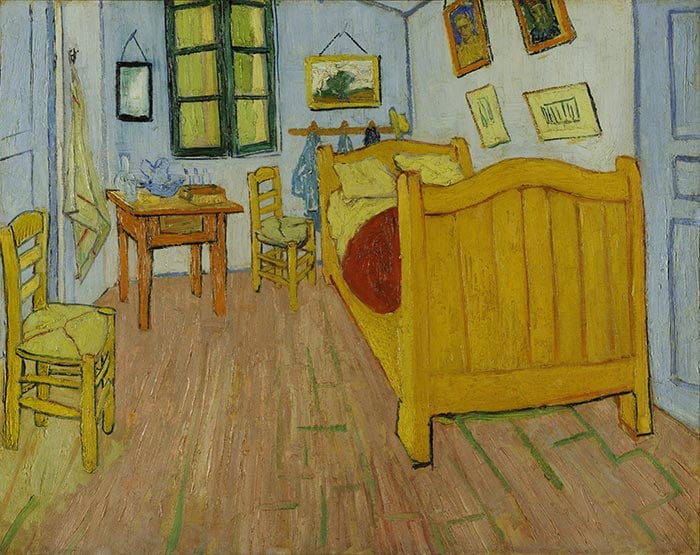
Vincent van Gogh, Bedroom in Arles, 1888 (First Version)
Key Facts
Here are some of the key facts about the painting:
- It depicts van Gogh's bedroom at 2 Place Lamartine in Arles, Bouches-du-Rhône, France, which is known as the "Yellow House". He had plans for the Yellow House to become an artist's colony where artists could stay and support each other. That never fully came to fruition, but he did manage to convince fellow artist and painter Paul Gauguin to stay. The door on the left-hand side in the painting leads to the guest room Gauguin stayed in. Below is a painting by van Gogh featuring the Yellow House:

Vincent van Gogh, The Yellow House, 1888
- Below is a letter and sketch he sent to Gauguin about the painting:
"I have done, still for my decoration, a size 30 canvas of my bedroom with the white deal furniture that you know. Well, I enormously enjoyed doing this interior of nothing at all. Of a simplicity à la Seurat.
With flat tints, but brushed on roughly, with a thick impasto, the walls pale lilac, the ground a faded broken red, the chairs and the bed chrome yellow, the pillows and the sheet a very pale green-citron, the blanket blood red, the washstand orange, the washbasin blue, the window green. By means of all these very diverse tones I have wanted to express an absolute restfulness, you see, and there is no white in it at all except a little note produced by the mirror with its black frame (in order to get the fourth pair of complementaries into it)."
Letter from Vincent van Gogh to Paul Gauguin dated 17 October 1888
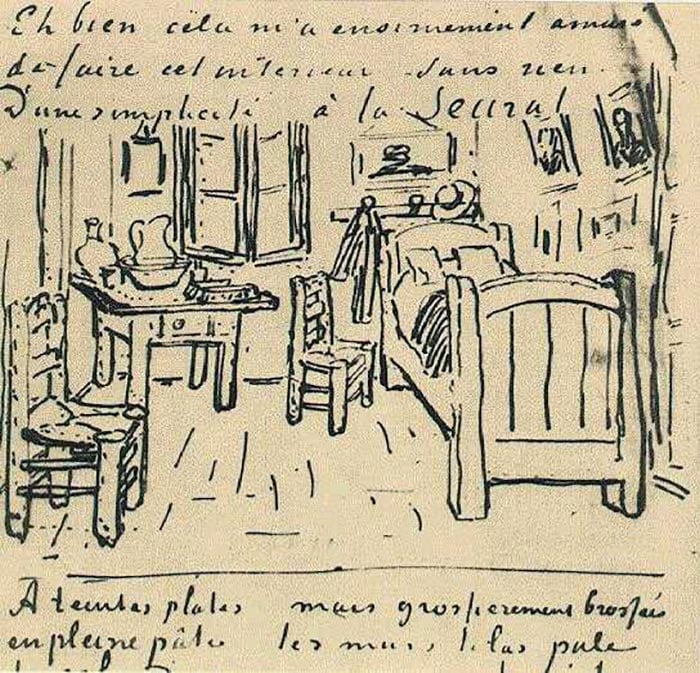
Vincent van Gogh, Sketch Sent to Paul Gauguin
- He sent a similar letter and sketch to his brother Theo about the painting:
My eyes are still tired by then I had a new idea in my head and here is the sketch of it. Another size 30 canvas. This time it's just simply my bedroom, only here colour is to do everything, and giving by its simplification a grander style to things, is to be suggestive here of rest or of sleep in general. In a word, looking at the picture ought to rest the brain, or rather the imagination.
The walls are pale violet. The floor is of red tiles.
The wood of the bed and chairs is the yellow of fresh butter, the sheets and pillows very light greenish-citron.
The coverlet scarlet. The window green.
The toilet table orange, the basin blue.
The doors lilac.
And that is all--there is nothing in this room with its closed shutters.
The broad lines of the furniture again must express inviolable rest. Portraits on the walls, and a mirror and a towel and some clothes.
The frame--as there is no white in the picture--will be white.
This by way of revenge for the enforced rest I was obliged to take.
I shall work on it again all day, but you see how simple the conception is. The shadows and the cast shadows are suppressed; it is painted in free flat tints like the Japanese prints. It is going to be a contrast to, for instance, the Tarascon diligence and the night café.
Letter 554 from Vincent van Gogh to Theo van Gogh dated 18 October 1888

Vincent van Gogh, Sketch Sent to His Brother Theo
- On 8 May 1889, van Gogh was committed to the mental asylum in Saint-Rémy. He stayed for a bit over a year until 16 May 1890. During this time, he remained busy creating numerous drawings and paintings, including two more versions ofBedroom in Arles, shown below:
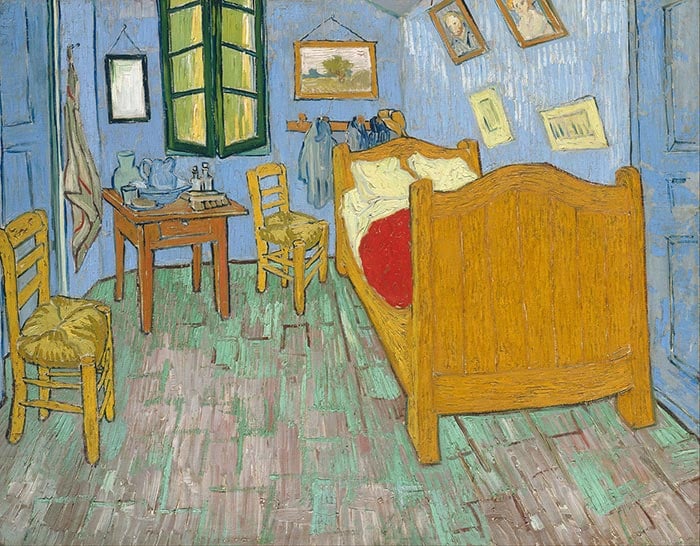
Vincent van Gogh, Bedroom in Arles (Second Version), 1889
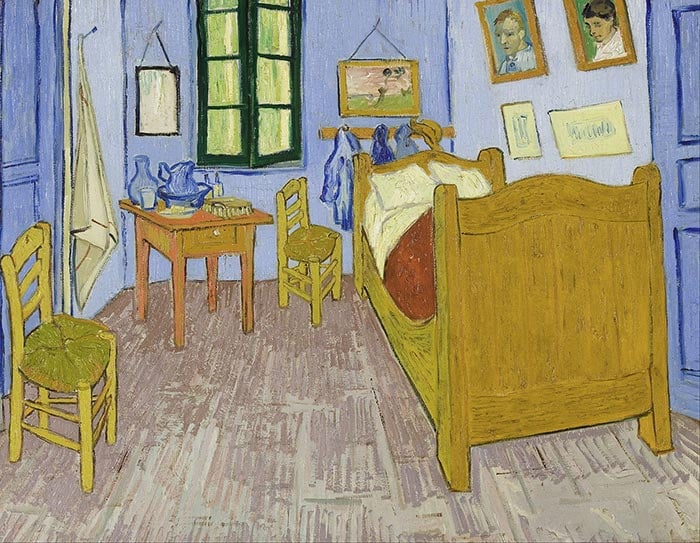
Vincent van Gogh, Bedroom in Arles (Third Version), 1889
Paintings on the Wall
The three versions of the painting are roughly the same, however if you look closely, you will notice the paintings on the wall change.
The original features a portrait of Eugène Boch namedThe Poet and a portrait of Paul-Eugène Milliet namedThe Lover.
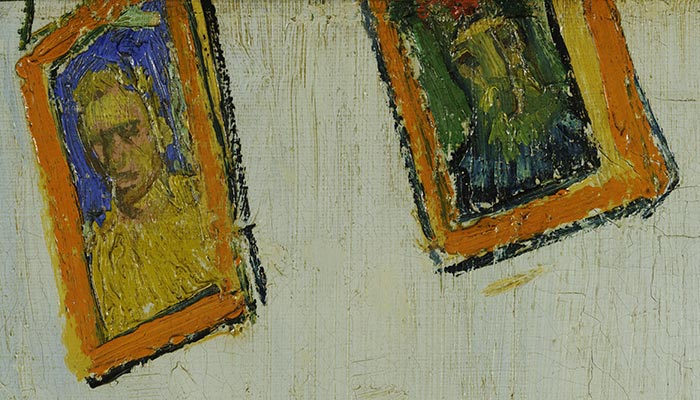
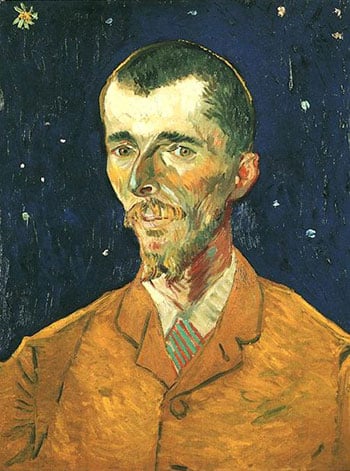
Vincent van Gogh, Portrait of Eugène Boch (The Poet), 1888

Vincent van Gogh, Portrait of Paul-Eugène Milliet (The Lover), 1888
In both the second and third versions of the painting, van Gogh used different combinations of a self-portrait and a portrait of an unknown woman.

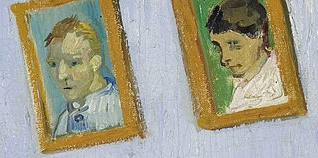
Use of Color
Van Gogh intended for color to be the main focus of the painting. In his own words, "This time it's just simply my bedroom, only here colour is to do everything, and giving by its simplification a grander style to things, is to be suggestive here of rest or of sleep in general."
The colorful mix of orange, red, blue, and green express the "absolute restfulness" of his bedroom.
Orange and red are rich and intense, whilst the blue and green are relatively weak and are used more so as accents. That is interesting because orange is a complement of blue and red is a complement of green. Remember that complementary colors have a striking contrast against each other. Van Gogh was actively thinking about his use of complementary colors in this painting, as he referenced them in his letter to Paul Gauguin dated 17 October 1888.
The "blood" red appears to be the most dominant color in the painting, which may signify the importance of the bed.
What I also find interesting is how flat the painting appears with color out of the picture. Apart from a few dark accents, the values are mostly compressed around the middle range. Color saturation and hue are clearly the heroes in this painting, rather than value.
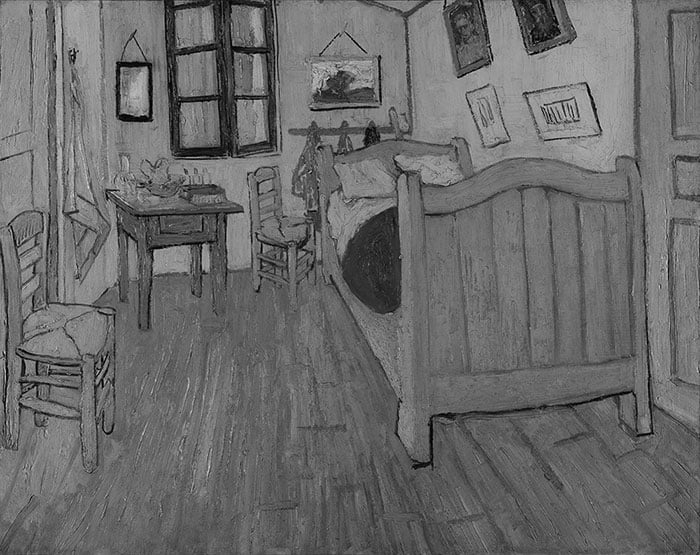
(If you want to learn more about color, make sure to grab my free Color Theory Cheat Sheet).
Awkward Perspective
There is a strong sense of perspective in the painting, with many of the rigid lines converging to a point around the middle. However, the sense of perspective is awkward and imperfect.
Part of this is probably due to van Gogh's artistic choices (he clearly was not focused on capturing the bedroom with complete realism). Another part is due to the obscure dimensions of the room, with the far wall with the window being on a slant. You can see an illustration of the room here.
Stylistic Outlining
In typical van Gogh style, most of the objects in the painting have a strong outline. This gives the painting a cartoonish and stylized appearance.
Notice how van Gogh used darker outlines around the bottom of objects (the close-up below is a great example). This is the only sign of any shading. In his letter to Theo dated 18 October 1888, he wrote, "The shadows and the cast shadows are suppressed; it is painted in free flat tints like the Japanese prints."

Rigid and Organic Shapes
The painting has a very rigid and angular theme, with mostly geometric shapes used to depict the bed frame, picture frames, tables, chairs, window, and doors. Some organic shapes are scattered amongst the painting for the bed cover, pillows, clothes hanging behind the bed, and towel hanging on the left-hand side. This creates a subtle contrast in shape, whilst retaining the overall rigid theme.
The rigid shapes also help emphasize the awkward sense of perspective in the painting (it is much easier to identify issues in perspective with rigid shapes than it is with organic shapes). This seems to go in favor of the overall appeal of the painting, despite it not being completely accurate.
Also, notice how outlines help reinforce the rigid shapes, whilst the organic shapes have much softer outlines.

(You might also be interested in my Painting Academy course. It goes into much more detail on the fundamentals of art.)
Key Takeaways
- Painting is not just about capturing what you see; it is also about capturing what you want to see or how the subject makes you feel. In this case, van Gogh wanted to capture the "absolute restfulness" of his bedroom.
- You can exaggerate and push certain elements in your painting to promote a certain theme. Van Gogh pushed the awkward perspective and use of color.
- It is easier to identify errors or inconsistencies in perspective with rigid shapes than it is with organic shapes.
Thanks for Reading!
Thanks for taking the time to read this post. I appreciate it! Feel free to share with friends. If you want more painting tips, check out my Painting Academy course.
Happy painting!

Dan Scott
Draw Paint Academy
Source: https://drawpaintacademy.com/bedroom-in-arles/

0 Komentar